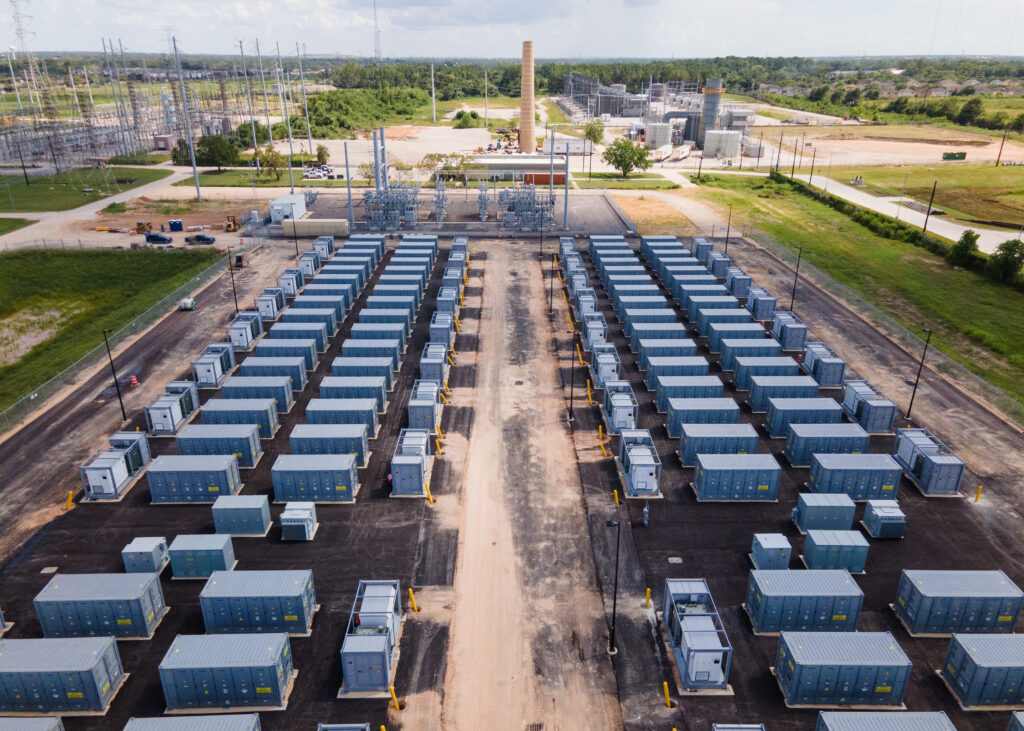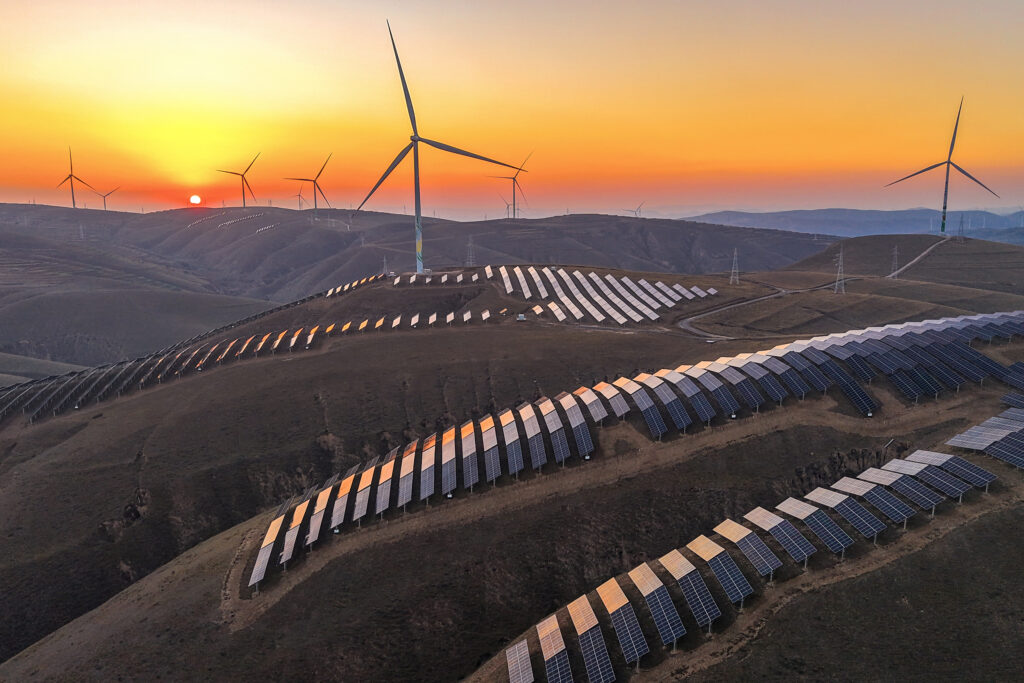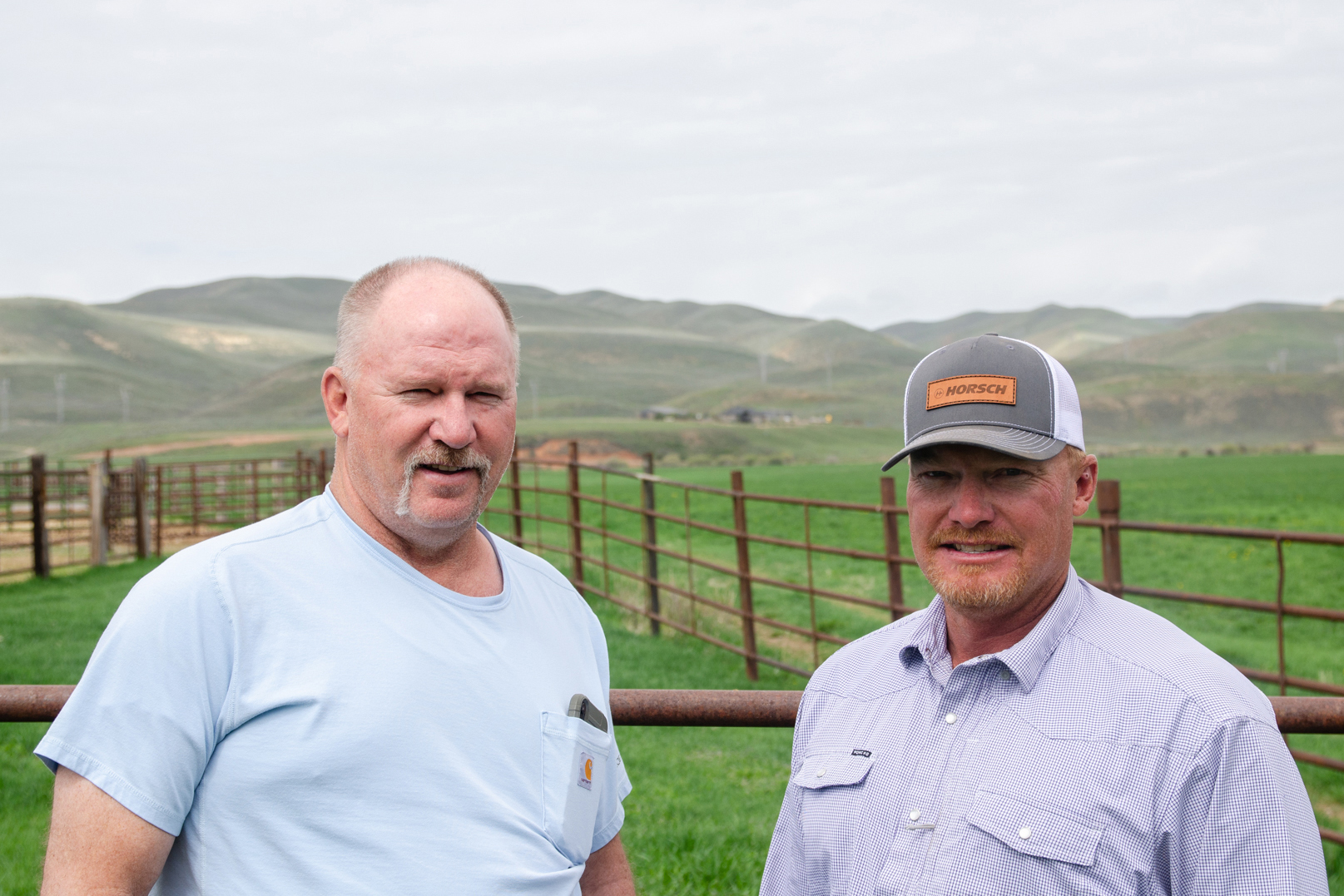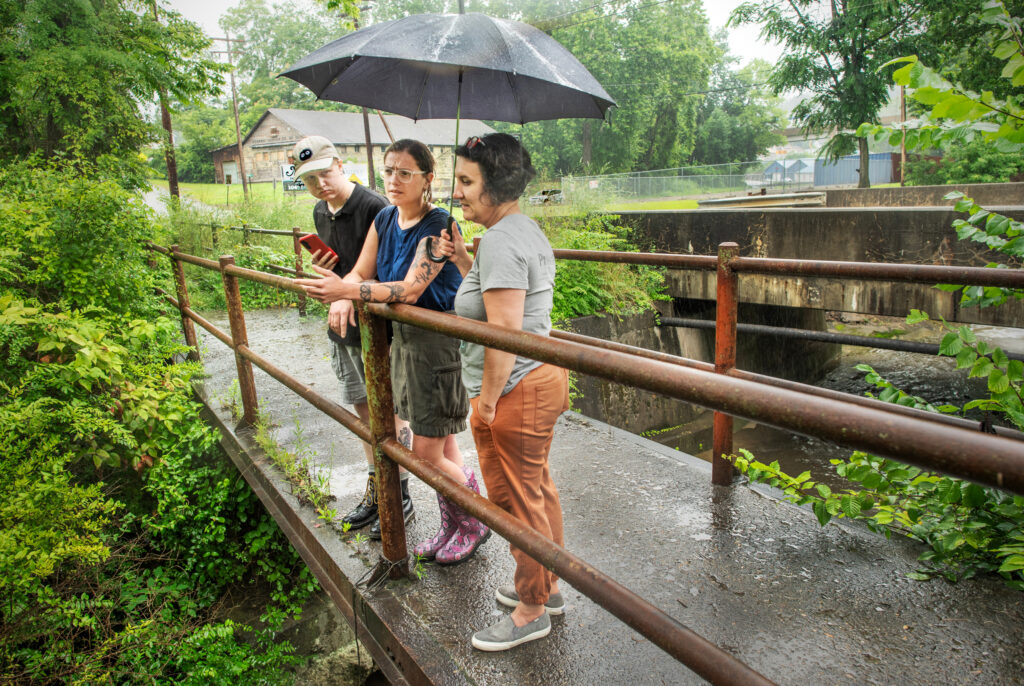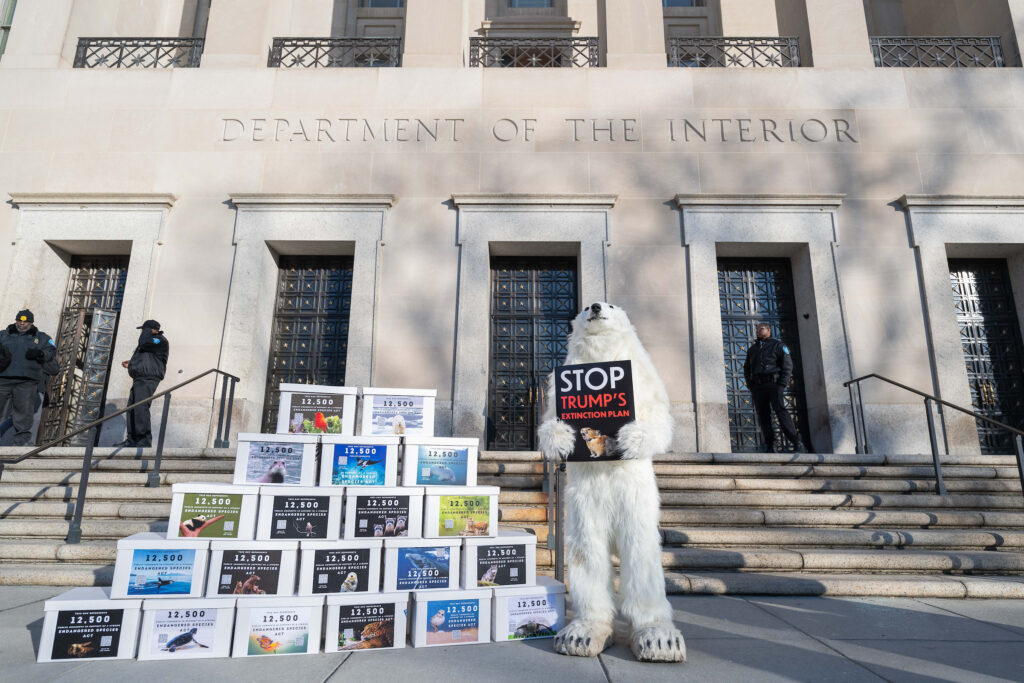Planet China: Fourth in a series about how Beijing’s trillion-dollar development plan is reshaping the globe—and the natural world.
NORTH SUMATRA, Indonesia—The scientists’ spirits were flagging. They’d been searching for orangutans in isolated patches of jungle across Sumatra, trying to see where the ape had improbably hung on outside its known range in the northern part of the island.
“As this trip went on, we became increasingly depressed,” said Serge Wich, a professor of primate biology at Liverpool John Moores University who was part of the team, “because there were no orangutans in any of these areas.”
It wasn’t until they reached the last site on their list that they found what they were looking for: intricate nests high in the trees. The discovery was a revelation—a new group of the critically endangered ape—so the scientists established a research station to gather more data.

As the animals became habituated to their observers, the researchers began noticing differences from the Sumatran orangutans farther north. Their hair was frizzier. The males’ calls were distinct. DNA collected from fecal samples showed differences, too. But it wasn’t until the scientists got their hands on a skull from a recently deceased orangutan that they confirmed their suspicions: They were dealing with a unique species.
The Tapanuli orangutan was the newest great ape, and there were fewer than 800 scattered across a swath of mountainous forest the size of Los Angeles.
The species was facing a range of threats, including an encroaching gold mine, palm oil plantations and hunting. Then, as the scientists were preparing to publish their findings in 2017, construction began on a hydroelectric dam smack in the middle of the orangutan’s habitat.
When the scientists sharpened their understanding of the dam project, they concluded that it posed an existential threat to the species.
“The Tapanuli orangutan was the latest extant great ape to be discovered,” Wich and the other scientists would later write, “but given its extremely small population numbers and current and projected threats, it might well be the first one to go extinct.”
Hydroelectric projects are big, expensive and risky, the type of infrastructure that Western-backed development banks have largely grown wary of.


But the Batang Toru dam, owned by Chinese and Indonesian companies and being built and financed by Chinese state-owned enterprises, presented an opportunity for both nations. Indonesia’s government was looking to expand its power grid, and in this case to do so without burning fossil fuels. Chinese companies were eager to finance and build these projects, and were willing to do so quickly and with few strings attached.
Dams had become a sizable part of China’s expansive overseas investment effort, known as the Belt and Road Initiative. Because Chinese companies usually build the dams, and tend to import at least some Chinese workers, hydroelectric projects support the initiative’s dual nature of promoting commercial and political interests, said Kirk Barlow, program director at the environmental advocacy group International Rivers.
“It fits well within this government-corporate portfolio,” Barlow said. “You’re trying to maintain good relations with your neighbors while providing economic opportunities for your country.”
As China erected dams across the developing world in the 2010s, however, the projects began generating controversy for their often devastating impacts on local communities and ecosystems. In addition to the Batang Toru dam, the two premier Chinese dam-builders were behind hydroelectric projects that threatened chimpanzees, gorillas, rhinoceroses and other endangered species across Africa and endangered river dolphins in Brazil, according to a 2021 report by International Rivers.




China’s support of new large-scale dams beyond its borders has since slowed, part of a larger pivot toward smaller investments meant to pose less financial, environmental and political risk. Yet as the ongoing construction of the Batang Toru dam and other projects highlight, Beijing’s state-owned enterprises continue to press forward on many projects with outsized environmental impacts.
Activists and scientists inside Indonesia and out had hoped to block the dam before it was too late—penning articles in prominent scientific journals, filing a lawsuit, pressuring Bank of China to withdraw its financing. But once they launched their campaign, they faced blowback and intimidation. Local activists received threatening calls and texts from unknown numbers. Some were brought in for questioning by the police. Two foreign scientists were dismissed from positions with a Swiss conservation group operating in Sumatra.
Neither the companies that own the dam nor several Chinese and Indonesian government offices or ministries responded to requests for comment for this article. The dam’s backers have said it would support Sumatra’s power grid while reducing greenhouse gas emissions. Any impacts on orangutans, they have claimed, would be small and can be largely mitigated.
By 2019, the campaign against the dam seemed to be gaining momentum even as advocates worried about their safety: Bank of China announced it was reevaluating the project based on environmentalists’ concerns.
But in October of that year, activists’ worst fears were realized in the dead of night, when one of their colleagues was brought to a hospital with life-threatening wounds.
People of the Forest
Sumatra was once covered in dense jungles, home to orangutans, tigers, rhinoceroses, elephants and thousands of other plant and animal species. Dutch colonists began clearing those forests in the early 1900s to make way for rubber, tobacco and coffee plantations.
The clearing continued throughout the century—nearly half of Sumatra’s forests disappeared from 1985 to 2007 alone. By the late 20th century, the island’s large, charismatic mammals had been wiped out across most of their historical range. For orangutans, the only populations known to remain were in the far north of the island, but rumors circulated of isolated populations farther south.
It was those rumors and earlier field work by other scientists that sent Wich and colleagues into the field in 2000 and 2001. In many of the areas they went to survey, they would later write, they arrived only to find that the forests visible in satellite maps from a year or two earlier were already logged or burnt to the ground.


Some scientists and conservationists speak of orangutans in reverential terms. Their name translates from Malay as “forest person,” and their anatomy is close enough to that of humans that those working with captive orangutans can call human doctors when the animals need medical help, one Indonesian conservationist said. The conservationist told a story of locking eyes with an orangutan in the forests of northern Sumatra—his first encounter with the ape.
“I fell in love,” he said.
Like several people interviewed for this article, the Indonesian conservationist spoke only on the condition of anonymity, for fear of government retaliation. Some scientists who have fought to protect Sumatra’s orangutans declined to be interviewed.
When Wich and a colleague arrived in the Batang Toru ecosystem, they found dense, mountainous forests separated by a rift valley. While the valley has been largely cleared for agriculture, much of the rest of the area is rugged enough to have avoided that fate. Fast-running streams cut steep gorges and cascading waterfalls between rounded emerald peaks.
Tucked into the folds are a wild array of plant and animal species—deep-red legless lizards, fluffy pygmy squirrels, purple lowland dwarf toads and poisonous rock frogs. Alien-like Thismia plants sprout from the forest floor like tubular mushrooms topped with neon-green leafy caps. Delicate orchids entice pollinators while the carnivorous and rare Nepenthes sumatrana traps and digests insects whole.
The forbidding landscape has provided a refuge for some of the world’s most critically endangered mammals, including Sumatran tigers and Sunda pangolins, and a total of at least 91 mammalian species, hundreds of types of birds, reptiles and amphibians and more than 1,000 plant species, according to the conservation group Yayasan Ekosistem Lestari.
As the scientists grew more confident that the Batang Toru orangutans were distinct, the final piece of evidence they needed, a skull, proved elusive. With so few orangutans in the area, “you can’t go around and get new ones easily,” said Wich, who has a gentle smile and closely cropped salt-and-pepper hair. “It was waiting on when an animal died, essentially.”
Their opportunity came in November 2013. When the skull measurements confirmed that the orangutans were a distinct species, the scientists felt a complicated mix of emotions.
“We were certainly very excited about it,” Wich said, “but at the same time we thought, ‘Well, then, this is also the great ape species with probably the lowest numbers.’”
Subsequent research would estimate that the Tapanuli orangutan once lived across a much wider area, its current range only about 2.5 percent of what it was in the 1890s. “Without preventing further losses to the population,” that paper said, “even if in the single numbers per year, the last remaining populations of the species are doomed to rapidly decline within several orangutan generation lengths,” with a generation equal to about 25 years. Current rates of killing or removals, the 2021 paper said, “already meet or exceed this threshold.”


By then, Tapanulis had been restricted to three population subgroups living in the mountains, separated by the rift valley in one direction and the Batang Toru river and a string of villages in the other. The dam’s construction would affect an area with some of the highest densities of orangutans in Batang Toru, about 5 percent of the total population or more than 40 individuals, according to a 2019 paper Wich co-authored. It would also lie right where the habitats of those three subgroups connect.
A 2020 environmental impact addendum prepared by the dam company said construction would alter about 1.5 square miles of orangutan habitat, though the company said it would restore about three-quarters of that area after construction was complete. The addendum estimated there were at least six orangutans living in the dam area.
Construction of the dam would involve diverting some of the Batang Toru river’s flow into a 222-acre reservoir, according to the addendum, which would be linked by a roughly eight-mile tunnel to a generating station downstream. Some 12 miles of new roads and nearly 9 miles of power lines would run parallel to the river, according to Wich’s paper, presenting additional barriers for the arboreal orangutans, who generally do not cross areas of broken forest.
Wich’s study determined that the dam could isolate the Tapanuli subgroups and drive the two smaller ones, with fewer than 200 individuals collectively, “to a status of nonviable.”
The larger habitat block to the north of the project site had more than 500 individuals, but in addition to the dam, the area was threatened by an expanding gold mine, hunting and other conflicts with humans.
It was this paper, published in April 2019, that concluded the dam might tip the Tapanuli toward extinction. The following month, two of Wich’s co-authors, foreigners who worked with PanEco, a Swiss conservation group focused on orangutan conservation in Sumatra, left their positions.
Inside Climate News was unable to reach one of the scientists while the other declined to speak for this article, but one of them told Science magazine in 2019, “We have been fired and kept in the dark.”
Regina Frey, PanEco’s founder and current president of its board of trustees, said in a recent interview that because the group worked under a memorandum of understanding with the Indonesian government, it was not in a position to openly oppose the dam. The scientists, she said, had been too confrontational in their approach. She said they left PanEco “in mutual agreement.”
Frey said she had determined it was better to avoid opposing the dam in order to maintain a relationship with the government and the company building it. While she denied that government pressure played any role in the scientists’ dismissal, Frey acknowledged that government officials were angry about their vocal opposition to the dam.
“‘What are you doing? You’re a partner with the government,’” Frey said of the officials’ reaction. Any pressure she felt from them, Frey added, was justified. “We did something wrong, actually. It’s not our role.”
Still, the government terminated its agreement with PanEco, Frey said. “We went too far in our opposition to the dam.”
Indonesia’s Directorate General of Nature Resources and Ecosystem Conservation, the agency responsible for protecting wildlife, did not respond to requests for comment.
“Be Careful”
By 2019, local activists were facing pressure far worse than dismissal.
Indonesia’s most prominent environmental advocacy group is known by its acronym, WALHI. Beginning the previous year, the staff of its North Sumatra branch, which was leading opposition to the dam, reported receiving threatening calls from unknown numbers. Its director had his movements closely tracked, the group has said.
One Indonesian activist, who spoke only on condition of remaining anonymous, said the Batang Toru dam was a priority for then-president Joko Widodo. Once the government succeeded in securing China’s backing, the activist said, officials felt pressure to deliver.
The activist was recounting his experience in an open-air restaurant in a town in North Sumatra, where he sat in a plastic chair smoking cigarettes. Speaking through a translator, he said special forces units from the Indonesian military were providing security for the dam at the time, and that the soldiers sometimes blocked environmentalists from visiting villages near the construction. Other times, it was people claiming to be villagers who issued warnings, telling activists not to visit. He received calls threatening violence if he didn’t stop speaking against the dam, the activist said, and at one point his phone was hacked.


Then, early in the morning on Oct. 3, 2019, Golfrid Siregar, WALHI North Sumatra’s legal manager, was brought to a hospital, unconscious and badly injured. The men who transported Siregar there reportedly told staff they had found him by the side of the road. He died from his injuries three days later.
The police would say the cause of death was a motorbike accident, but people close to him doubted this finding and pointed to numerous irregularities. Siregar suffered primarily from head injuries, for example, while the rest of his body was largely uninjured, according to an open letter composed soon after his death by Friends of the Earth Asia Pacific. His clothes were muddied, yet the spot where his body was supposedly found was dry and paved. Siregar’s laptop, wallet and ring were missing, as was his helmet, the letter said.
According to WALHI North Sumatra, police conducted an autopsy but refused to release the results.
Friends of the Earth was soon joined by Amnesty International, which sent an open letter to Widodo, the president, calling for an investigation. The letter said Siregar’s death was part of a pattern of attacks against or arrests of activists.
“The organization expresses deep concern about the incidents that led to his death,” the Amnesty International letter said, “and the possibility that these were connected to his human rights and environmental work.”
The day before he was brought to the hospital, Siregar had sent a text message to a colleague expressing concern, according to a screenshot shared with Inside Climate News.
“It seems like something is up,” Siregar wrote in the Bahasa Indonesia language, referring to the possibility someone might get stabbed. “Be careful,” he warned his colleague, “there’s been a lot of tricks and betrayal.”
The dam owner, North Sumatera Hydro Energy, or NSHE, was at that point majority owned by a subsidiary of Zhefu Holding Group, an energy equipment manufacturing company based in China.
The remaining shares were held by Indonesia’s state-owned utility and a Singapore-based company that was owned by “several Indonesian individuals who develop projects in the renewable energy sector,” according to a World Bank Group disclosure related to a separate hydroelectric project.


The principal financier had been Bank of China, meaning the project was majority owned, built and financed by Chinese companies.
Neither the parent companies of NSHE nor the North Sumatra Police responded to requests for comment, though NSHE’s chief executive at the time publicly denied having anything to do with Siregar’s death.
The incident generated international media attention, but Indonesian activists opposed to the dam continued to face pressure. According to WALHI North Sumatra and media reports, regional police soon summoned the advocacy group’s director and, separately, a local scientist who had criticized the project. Both had been the subject of complaints, one brought by NSHE and the other by a Jakarta-based public relations firm hired by NSHE, according to WALHI and the reports.
It is unclear who was behind the threatening phone calls and texts, or what exactly motivated Indonesian officials to pressure scientists and conservationists who spoke against the Batang Toru dam.
There is no evidence Chinese management directed or was aware of any of the pressure. China’s pitch for its Belt and Road projects, many experts say, is that the country’s money and expertise comes without the imperialist interventions imposed by Western lenders—no requirements for developing nations to cut government spending, say, or meet demands for human rights reforms. That hands-off approach, the experts say, also means Chinese enterprises tend to leave management of social conflicts and human rights risks to local authorities.
Construction of the dam has also been plagued by deadly accidents, according to multiple media reports. One local who said he worked onsite until earlier this year told Inside Climate News that accidents were common and that he’d seen colleagues fall to their deaths. The man asked that his name not be published, for fear of retribution.


Inside Climate News was unable to reach NSHE. The company’s website is defunct. A phone number from the 2020 environmental impact addendum was answered by a man who said the company had vacated that office.
Around the time Siregar died, word began to spread that Bank of China had withdrawn funding. While the bank never made a public statement, and did not respond to Inside Climate News’ questions about the matter, in early 2020 it confirmed privately that it was not backing the dam.
Much like with the discovery of a new species, the developments of late 2019 brought a painful mix of emotions for the dam’s opponents. Wich said he and others thought that when Bank of China withdrew, the project might be canceled. But Siregar’s death, and the suspicious circumstances surrounding it, also caused Wich to rethink his work.
“After Golfrid died I decided not to go to Indonesia for a while,” Wich, who lives in the United Kingdom, said recently.
COVID-19 hit soon after. In June 2020, PLN, Indonesia’s state-owned utility and a minority owner of the dam, announced that the project was delayed, citing the pandemic and the protests from environmental groups. By the following year, however, NSHE had a new majority owner: SDIC Power Holdings, a subsidiary of the State Development and Investment Corp., a large Chinese state-owned enterprise. With Bank of China gone, the new owners would eventually secure financing from the Export-Import Bank of China, a state policy bank.
SDIC Power did not respond to requests for comment.
Frey said that until 2020, PanEco had been in regular touch with NSHE, working to see how they might mitigate impacts on orangutans. After SDIC Power took control, she said, the communication ended.
“We thought we were in a very bad spot” in 2019, Frey said. “No, we are now in a very bad spot.”
“Clapping With One Hand”
Julius Siregar is the conservation director with Yayasan Ekosistem Lestari, or YEL, a Sumatran conservation group that Frey co-founded and that works with PanEco. Unlike its Swiss partner, YEL still has a memorandum of understanding with the Indonesian government, which allows it to receive orphaned or confiscated orangutans and work to rehabilitate and release them back to the wild. The group also maintains a research station in the Batang Toru ecosystem.


YEL initially opposed the dam but pivoted in 2020, said Siregar, who is not related to Golfrid Siregar. The group thought it could play a more constructive role that way, given the government’s determination to complete the project.
YEL’s top priority is to establish a protected corridor that will allow orangutans to pass between the isolated habitats. Yet the dam and reservoir construction sites lie within that proposed corridor, Siregar said.
The group has tried to share this information with NSHE, but Siregar said the messages do not seem to have received a positive response from the company’s management.
“We are clapping with one hand,” Siregar said, speaking through a translator.
He was speaking from a conference room in YEL’s office, in a residential neighborhood of Medan, Sumatra’s largest city. Air conditioning kept the steamy outside air at bay. On the wall were photos of orangutans, a satellite map of Batang Toru and three clocks set to time zones in Indonesia, London and Zurich, where its funders and partners were.
About 20 percent of the Tapanuli orangutans live in patches of forest that currently are not protected, Siregar said. Over the past several years, YEL has received a handful of baby orangutans, he said, generally a sign the mother has been killed. If the current situation continues with dam construction and other development, “there will be more wildlife conflict,” Siregar said. “There will be deaths.”
Environmental groups have questioned the need for the dam. According to a 2020 analysis commissioned by Indonesian advocacy groups, North Sumatra had one of the highest electrification rates in Indonesia, about 96 percent, with a surplus in generating capacity as of 2018. There had been a history of rolling blackouts, it noted, but the analysis said the problem had already improved with the completion of new generating units and that other power sources could replace the dam.


NSHE has said the 510-megawatt-capacity project will provide power at times of peak demand and will reduce greenhouse gas emissions by 1.6 million to 2.2 million tons per year, by displacing or avoiding fossil-fuel-generated power. Environmental groups contend those figures are overstated.
The 2020 environmental impact addendum prepared by NSHE said the company would take measures to mitigate impacts on orangutans, including minimizing the felling of fruit-bearing trees and constructing arboreal bridges over roads.
Yet the lack of publicly available information or communication with NSHE or government agencies makes it difficult to assess the status of the dam project, what its impacts will be or which steps the company is taking to reduce them.
Barita Manullang, who worked for NSHE as an internal adviser on orangutan conservation until his retirement in January 2024, said the company did replant native trees in certain areas. But he said the company never endorsed his proposal to conduct a survey of orangutans in the dam area, a step that would have required a full-time staff.
“It’s very difficult to introduce the idea of conservation of orangutan to them,” Manullang said, speaking of NSHE. “The company always thinks from the economical point of view.”
Activists and scientists say the ape’s best hope lies in the various parties beginning to cooperate.
This story is funded by readers like you.
Our nonprofit newsroom provides award-winning climate coverage free of charge and advertising. We rely on donations from readers like you to keep going. Please donate now to support our work.
Donate Now
“The problem at the moment for the Tapanuli orangutan is the lack of collaboration between all the actors there,” said Wich, the scientist who took part in early surveys of the species. “There’s no action plan for this species based on the best possible knowledge out there, and that’s really unfortunate,” he added. “We could, if everyone would sit together, try to make a solid plan that would hopefully safeguard the species. It’s not too late for that—it’s still possible. But the longer we do not do that, the more difficult the situation for the species will become.”
Wich has not returned to Indonesia since Golfrid Siregar’s death. In 2022, the government barred Wich and four other scientists from working in the country’s national parks when they published an opinion article in an Indonesian newspaper challenging an official’s statement that the populations of the three orangutan species—including Sumatran and Bornean orangutans—were increasing.
After a new administration reorganized government ministries late last year, however, Wich said the prohibition is now null, and he’s considering returning. The new government, he said, appears more open to dialogue.
Living With the Tapanuli—for Now
In late afternoon, the winding road that runs parallel to the Batang Toru river fills with workers on motorbikes in blue jumpsuits bearing the name Sinohydro, the Chinese state-owned company contracted to build the dam.
On a blazing hot day in June, a team of WALHI North Sumatra activists drove this tortuous route to visit local partners in villages near the dam who are trying to protect the forests from encroachment. Their battered SUV swerved around white plastic sheets covered in coffee beans laid out in the road to dry in the sun. A mix of wooden shacks and concrete bungalows lined the road. They drove past a palm oil plantation carved out of the forest and another area recently cleared for planting.
WALHI is one of the only Indonesian groups that remains openly opposed to the Batang Toru dam, yet it, too, has changed course. The group campaigns more generally on protecting the Batang Toru ecosystem as a whole and lately has focused more on the nearby gold mine, which is continuing to expand.


In the years since SDIC Power bought the dam, Sinohydro and its contractors have been busy digging the tunnel to carry water from the reservoir to the power station downslope—a company filing says the tunnel was completed in 2023. Contractors have used dynamite to blast the gorge’s steep, forested hillsides, covering the slopes with concrete to prevent landslides.
Villagers say the work has sent animals out of the forest and into their farms and fruit groves. In one village, a man who asked that his name not be published said hordes of monkeys have invaded their fields, sometimes hundreds at a time, eating anything they can—durians, snake fruit, coffee, cacao. Neither NSHE nor its contractors have offered any help, he said.
After a winding drive, the activists stopped in another village, a mile or so from the dam’s power station, where WALHI has been supporting efforts to develop agroforestry. The group crowded into a small shop with dirt floors, where a woman served sugar palm sap and gritty coffee made from local robusta beans.
One villager who asked not to be named said he worked as a cement mixer at the dam site. He supported the project, he said, because it has provided jobs to locals. Since he began in 2017, he’d seen a pair of orangutans on site twice.
Another man walked in and showed a video on his cell phone of a young male orangutan high in a tree. He’d taken the video last year at the edge of the village, he said, where the animals sometimes come down from the mountain to eat fruit. In the video, the orangutan was breaking off branches and tossing them down, trying to scare the man off. The animal stared piercingly at the camera. The man said the villagers once viewed orangutans as pests, but they’ve come to learn to live with them. Some villagers see them as sacred, he said.
As the group drank coffee and smoked cigarettes in the afternoon’s heavy heat, a man wearing fatigues drove up on a dirt bike, with a rifle and two large knives slung across his back. His name was Sumitro and he worked as a ranger in the Lubuk Raya forest, a protected area on the slopes of a dormant volcano that rises above the village.




Over the past year, Sumitro said, he’d seen three orangutans in the reserve. They were some of the apes that scientists warn the dam might isolate from the rest of the species.
Meanwhile, another company has been prospecting the area for a possible geothermal power project.
“We only hope we can work together with all the stakeholders to protect the forest and not have any more high-priority projects that would threaten the forest,” Sumitro said, speaking through a translator. “Hopefully the hydrodam is the last.”
The men were eager to show the village’s crops, coffee and palm sugar growing at the forest’s edge and snake fruit palms under its dense, dark canopy. A path led deeper into the forest, climbing the slope of Lubuk Raya, up one of the mountain islands where the last Tapanuli orangutans live.
About This Story
Perhaps you noticed: This story, like all the news we publish, is free to read. That’s because Inside Climate News is a 501c3 nonprofit organization. We do not charge a subscription fee, lock our news behind a paywall, or clutter our website with ads. We make our news on climate and the environment freely available to you and anyone who wants it.
That’s not all. We also share our news for free with scores of other media organizations around the country. Many of them can’t afford to do environmental journalism of their own. We’ve built bureaus from coast to coast to report local stories, collaborate with local newsrooms and co-publish articles so that this vital work is shared as widely as possible.
Two of us launched ICN in 2007. Six years later we earned a Pulitzer Prize for National Reporting, and now we run the oldest and largest dedicated climate newsroom in the nation. We tell the story in all its complexity. We hold polluters accountable. We expose environmental injustice. We debunk misinformation. We scrutinize solutions and inspire action.
Donations from readers like you fund every aspect of what we do. If you don’t already, will you support our ongoing work, our reporting on the biggest crisis facing our planet, and help us reach even more readers in more places?
Please take a moment to make a tax-deductible donation. Every one of them makes a difference.
Thank you,





